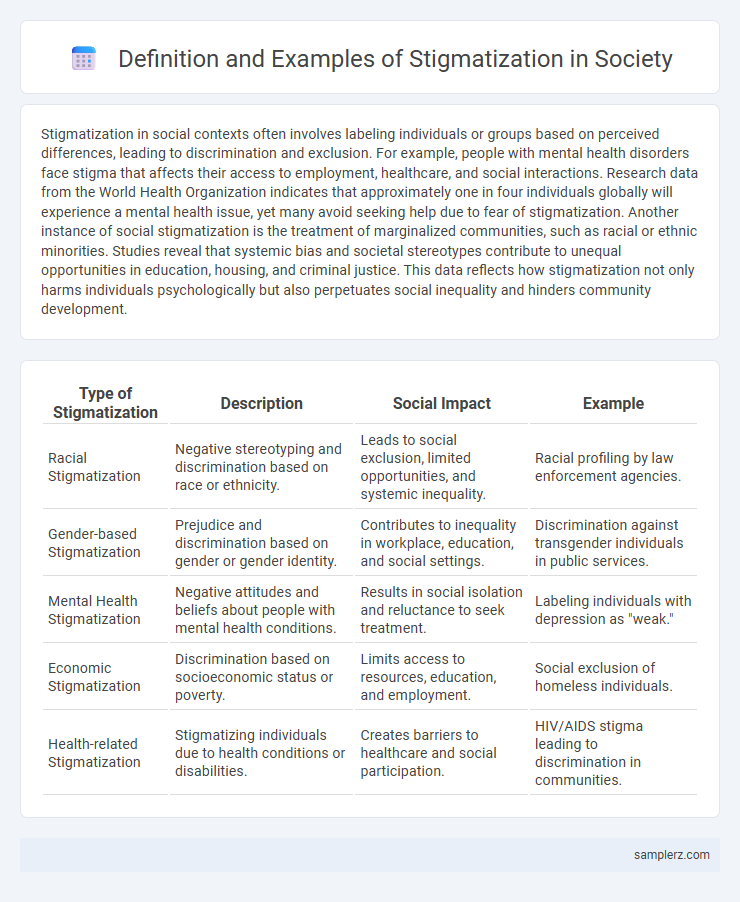Stigmatization in social contexts often involves labeling individuals or groups based on perceived differences, leading to discrimination and exclusion. For example, people with mental health disorders face stigma that affects their access to employment, healthcare, and social interactions. Research data from the World Health Organization indicates that approximately one in four individuals globally will experience a mental health issue, yet many avoid seeking help due to fear of stigmatization. Another instance of social stigmatization is the treatment of marginalized communities, such as racial or ethnic minorities. Studies reveal that systemic bias and societal stereotypes contribute to unequal opportunities in education, housing, and criminal justice. This data reflects how stigmatization not only harms individuals psychologically but also perpetuates social inequality and hinders community development.
Table of Comparison
| Type of Stigmatization | Description | Social Impact | Example |
|---|---|---|---|
| Racial Stigmatization | Negative stereotyping and discrimination based on race or ethnicity. | Leads to social exclusion, limited opportunities, and systemic inequality. | Racial profiling by law enforcement agencies. |
| Gender-based Stigmatization | Prejudice and discrimination based on gender or gender identity. | Contributes to inequality in workplace, education, and social settings. | Discrimination against transgender individuals in public services. |
| Mental Health Stigmatization | Negative attitudes and beliefs about people with mental health conditions. | Results in social isolation and reluctance to seek treatment. | Labeling individuals with depression as "weak." |
| Economic Stigmatization | Discrimination based on socioeconomic status or poverty. | Limits access to resources, education, and employment. | Social exclusion of homeless individuals. |
| Health-related Stigmatization | Stigmatizing individuals due to health conditions or disabilities. | Creates barriers to healthcare and social participation. | HIV/AIDS stigma leading to discrimination in communities. |
Everyday Instances of Social Stigmatization
Everyday instances of social stigmatization often manifest through subtle exclusion or negative stereotypes directed at marginalized groups, such as the homeless, people with mental illness, or individuals from minority ethnic backgrounds. These social biases result in barriers to employment, housing, and social services, reinforcing cycles of inequality. The persistent nature of microaggressions and prejudiced assumptions significantly impacts the psychological well-being and social integration of affected individuals.
Stigmatization of Mental Health Issues
Stigmatization of mental health issues often leads to discrimination in workplaces and educational institutions, reducing opportunities for affected individuals. This negative bias results in social isolation and discourages people from seeking timely treatment, worsening their condition. Public awareness campaigns and supportive policies are essential to dismantle these harmful stereotypes and promote mental well-being.
Social Stigma Surrounding Addiction
Social stigma surrounding addiction often manifests through negative stereotypes, such as viewing individuals with substance use disorders as morally weak or dangerous. This stigma contributes to social exclusion, reduced access to healthcare, and increased barriers to recovery for affected individuals. Studies show that addressing these misconceptions through education and support can significantly improve treatment outcomes and social reintegration.
HIV/AIDS-Related Stigma in Communities
HIV/AIDS-related stigma in communities often manifests through discrimination, exclusion, and misinformation, leading to social isolation of affected individuals. This stigma can result in reduced access to healthcare, employment challenges, and increased mental health issues among people living with HIV/AIDS. Campaigns promoting education and empathy play a critical role in reducing stigma and improving the quality of life for those impacted.
Stigmatization of Poverty and Homelessness
Stigmatization of poverty and homelessness often leads to social exclusion and discrimination, exacerbating barriers to employment, housing, and healthcare access for affected individuals. Negative stereotypes portray homeless people as lazy or irresponsible, reinforcing public prejudice and justifying inadequate policy responses. This social bias perpetuates cycles of marginalization, hindering efforts to address systemic causes of poverty and homelessness effectively.
Cultural and Ethnic Minority Stigma
Cultural and ethnic minority stigma often manifests through systemic discrimination, such as limited access to education, healthcare, and employment opportunities for marginalized groups. Negative stereotypes and prejudices contribute to social exclusion, reinforcing disparities in socioeconomic status and mental health outcomes. Efforts to combat this stigma focus on promoting diversity, inclusion, and culturally sensitive policies within institutions and communities.
Stigma Faced by the LGBTQ+ Community
The LGBTQ+ community experiences stigmatization through social exclusion, discrimination in employment, and unequal access to healthcare. Negative stereotypes and prejudices lead to increased mental health issues such as anxiety and depression among LGBTQ+ individuals. Societal bias contributes to higher rates of homelessness and violence targeting LGBTQ+ youth, highlighting the urgent need for inclusive policies and social acceptance.
Body Image and Appearance-Based Stigmatization
Body image and appearance-based stigmatization significantly impact individuals, often leading to social exclusion, bullying, and mental health challenges such as depression and anxiety. People with non-conforming body types, visible scars, or skin conditions frequently face discrimination in workplaces, schools, and public settings. This stigmatization perpetuates negative stereotypes and reinforces societal pressure to adhere to unrealistic beauty standards, undermining self-esteem and social inclusion.
Ageism and Discrimination Against the Elderly
Ageism, a prevalent form of stigmatization in social contexts, leads to widespread discrimination against the elderly, affecting employment opportunities, healthcare access, and social inclusion. Studies show that older adults face stereotypes portraying them as less competent, which exacerbates isolation and mental health challenges. Policies promoting age diversity and inclusive practices are essential to combat negative biases and enhance the quality of life for aging populations.
Stigmatization in Educational Environments
Stigmatization in educational environments often manifests through discriminatory labeling of students based on learning disabilities, socioeconomic status, or cultural background. This negative stereotyping can lead to social exclusion, reduced academic performance, and long-term psychological effects such as low self-esteem and anxiety. Research shows that inclusive teaching practices and anti-bullying policies significantly decrease stigmatization and improve student well-being and academic success.

example of stigmatization in social Infographic
 samplerz.com
samplerz.com